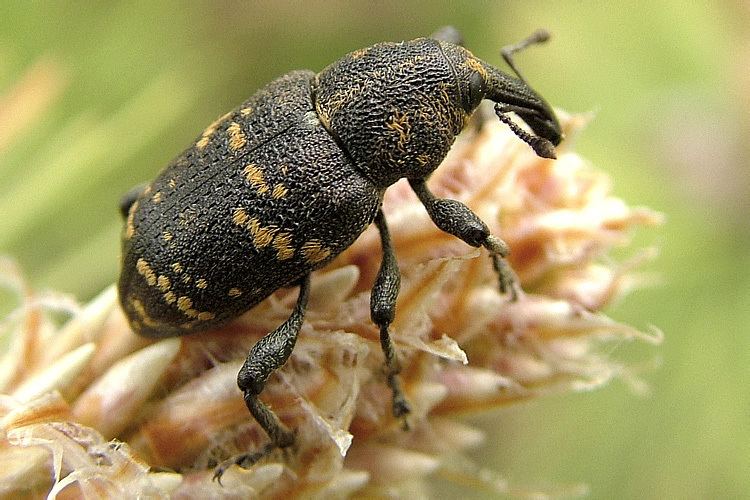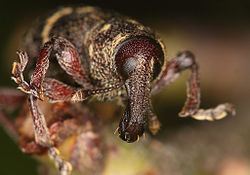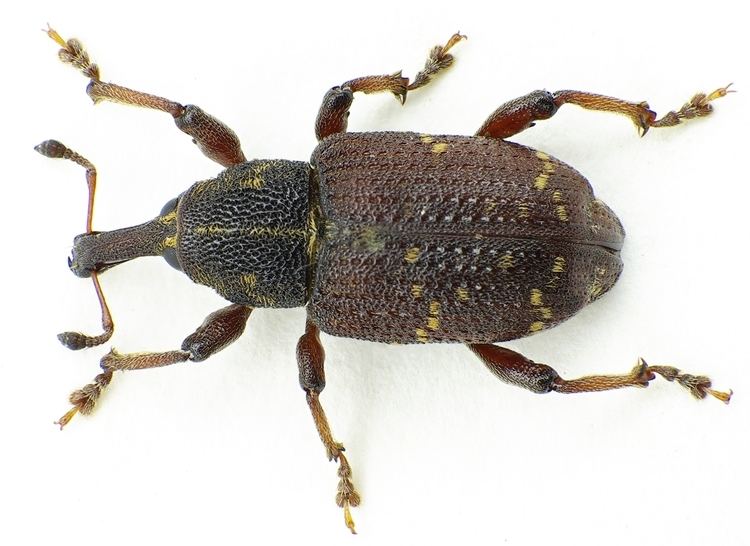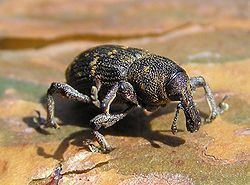Order Coleoptera Rank Species | Superfamily Curculionoidea Genus Hylobius Higher classification Hylobius | |
 | ||
Similar Hylobius, Beetle, Insect, True weevils, Weevil | ||
Sound of a pine weevil hylobius abietis feeding on a conifer seedling
Hylobius abietis or the large pine weevil is a beetle belonging to Curculionidae family. This species is widely regarded as the most important pest of most commercially important coniferous trees in European plantations. Seedlings planted or arising from natural regeneration (germinated seed-fall) after clear felling operations are especially at risk. The adult weevils cause damage by eating the bark of seedlings around the 'collar' of the stem, thus 'ring-barking' the tree seedling which usually results in its demise.
Contents
- Sound of a pine weevil hylobius abietis feeding on a conifer seedling
- Pine weevil hylobius abietis chased by perelitus areolaris
- Description
- Behaviour
- Life cycle
- Damage
- Control
- Trapping out and population suppression
- Silvicultural countermeasures
- Biological control
- References

Pine weevil hylobius abietis chased by perelitus areolaris
Description

The adult weevils are approximately 10–13 mm (0.39–0.51 in) in length (without beak/snout) and are dark brown with patches of yellow or light brown hairs arranged in irregular rows on their elytra. The legs are black or deep red with a distinctive tooth on the femora and at the end of tibiae. The full grown larvae are 14–16 mm (0.55–0.63 in), typical for weevils, apodial, curved and are whitish, with brown head.
Behaviour

Adults can be found all year long although they usually hibernate during the cold winter months. The reproduction ready images are attracted to freshly cut stumps of conifers. Eggs are deposited singly (one or two per day) under the ground into stamp thick roots or in the soil in their vicinity. Large pine weevils can locate spots on the ground to dig into in a great precision using olfactory cues. Mating also usually takes place in the soil. To get maturation, adults feed on the bark and phloem of seedlings and young conifers, but sometimes also deciduous trees, causing severe growth loss, stem deformities sand increased mortality. Thus, in the years following the clearing of plots and planting of new seedlings, adults that hatch in large numbers may cause a plague.

The large pine weevils have a tendency to attack artificially fertilized trees, especially those fertilized with phosphorus which causes greater nutritional quality of phloem for the weevils or make faster more attractive plants for the weevils due to faster growing.
Life cycle

In the spring, after hibernation, in the ground in the forest litter, females lay eggs on in or near the roots, of freshly felled trees or sick. A female can lay up to 100 eggs in her life. The larvae hatch after 2 or 3 weeks, and feed under the bark, excavating galleries and complete development, ending with pupation case, leaving the entrance blocked by sawdust. The pupae are immobile, cream in colour and soft bodied. This phase lasts 2 or 3 weeks, after which the insect leaves the chamber as an adult. With favorable weather the entire development lasts four to five months. The oviposition takes place in April or May, so the weevils emerge in August or September, but are not sexually active until after the winter. The imago lives from two to three years, during which it reproduce in following seasons. In colder seasons the larval development is longer and then the whole cycle lasts twelve months, resulting that imagos able to reproduce quickly. Biennial generation it is also common, by which the larvae hatch from eggs laid in May, live through the whole season overwinter and the imago appears in July or August next year.
Damage

The main damage is caused by the adults that feed on the bark and the cambium. The imago eats throughout the growing season, but the especially intensive attacks are observed April–May (spring attack) and from August to September (autumn attack). Clear cuttings, if not followed by burning or removing of the thick branches and stumps favor the spread of the pest.
Control
Insecticides (mainly seedling dressing) provide the mainly used method of protection transplant from H. abietis feeding damage. Now other methods are being considered, like the use of natural parasites. Physical barriers of seedlings are also used in some of the European countries.
Trapping-out and population suppression
For more than 100 years, different ways of suppressing the weevil population have been tried, generally with poor results. Some of these techniques are still useful either as tools to monitor weevil populations. Debarking of stumps was also practiced as a weevil suppression technique, but is now abandoned as laborious and inefficient.
Silvicultural countermeasures
The pine weevil problem is very much related to the practice of clear-felling and planting. There is clear evidence showing that pine weevil problems are smaller in natural regeneration than in plantations. Natural regeneration is often a good strategy to avoid Hylobius damage at sites where it can be practiced, but old spruce stands are often unstable and natural regeneration hence risky.
Biological control
Various natural enemies attack immature and adult pine weevils in the wild. Natural enemies include predatory beetles, insect killing fungi, microscopic insect killing worms (entomopathogenic nematodes) and a parasitic wasp, Bracon hylobii. Ground beetles, nematodes and fungi can kill both immature and adult weevils. The parasitic wasp attacks pine weevil larvae only. Entomopathogenic nematodes are microscopic worms that kill only insects. Nematodes of the families Steinernematidae and Heterorhabditidae are used as biological insecticides against a number of soils inhabiting insect pest. Laboratory and field research has demonstrated that the larval, pupal and adult stages of H. abietis are susceptible to these nematodes. In contrast, the parasitic wasp B. Hylobii, kills only the larval stage of H. abietis. The life cycles of entomopathogenic nematodes and B. hylobii are well adapted to their host and both are capable of locating, infecting and killing H. abietis in the concealed environment of the tree stump. (The potential for biological control to reduce hylobius abietis damage, by Julia Brixey) In 1994 was treated in Asturias (Spain), because of great attack, with Metoxicloro 1% in 20 ha affected. The result was quite good, but the problem was not totally solved.
